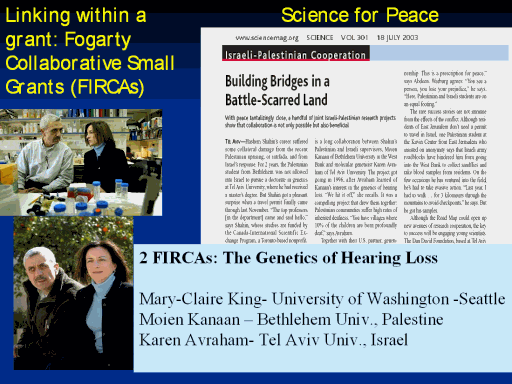 |
is a long collaboration between Shahin’s Palestinian and
Israeli supervisors, Moien Kanaan of Bethlehem University in the West
Bank and molecular geneticist Karen Avraham of Tel Aviv University. The
project got going in 1996, after Avraham learned of Kanaan’s interest in
the genetics of hearing loss. “We hit it off,” she recalls. It was a
compelling project that drew them together: Palestinian communities
suffer high rates of inherited deafness. “You have villages where 10% of
the children are born profoundly deaf,” says Avraham. Together with
their U.S. partner, geneticist Mary-Claire King of the University of
Washington, Seattle, the scientists are tracking down genes involved in
inherited deafness. To date, they have identified four genes and have
collected data on 59 Israeli and 74 Palestinian families that, they
hope, should help pin down further genes.
Many Israeli scientists are open to collaboration with Palestinian and
other Arab scientists. Take the joint graduate programme between Tel
Aviv University and Bethlehem University involving geneticist
Mary-Claire King at the University of Washington. This project is
looking at the genetic origins of deafness, and the Middle East is ideal
for such research, as rich pedigrees are available because marrying
close relatives is unusually common. Moreover, Bethlehem researchers
have spent time in King’s laboratory, bringing back new skills to
Palestine. the three-way collaboration is an example of a successful
effort to maintain such constructive contact. This is just one example
of partnerships involving Israel, its neighbours and scientists in
Europe or the United States. Israel is a research powerhouse that, given
an eventual improvement of relations with its neighbours, could
rejuvenate science and development in the region through collaboration
and training.
|
